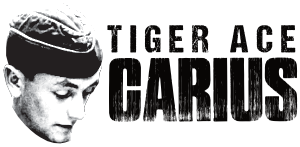The LIFE of
Otto Carius

Bullets Catched
Tanks & AT Guns downed
Decorations
The Lost Generation
maelstrom of World War II
Like many others of his generation, Otto Carius was abruptly torn from his youth and lived through the hell of the Great War.

The man who refused to die
Together with Kurt Knispel, Michael Wittmann and Johannes Bölter, Otto Carius is considered one of the most successful tank commanders of World War II and he received one of the highest awards of the Third Reich, the Knight’s Cross of the Iron Cross with Oak Leaves.
The platoon commander of the heavy tank division 502 was considered an outstanding tactician of tank combat. After the war, he became a pharmacist and published a memoir, “Tiger in the Mud,” in 1960. Carius became the most important contemporary witness of the Tiger tank through the book and his interviews – also because he survived the war.
Carius is one of the popular soldier figures. He appeared in documentaries, his missions are imitated in computer games, there is a manga about him and you can buy him as an action figure. Until his death, he signed and sold his book in his pharmacy.
Timeline
1922-1940
Early Life
Born on May 27, 1922, Carius attended elementary school from 1928 and then the Humanist Gymnasium in Zweibrücken from 1932 to 1940. After graduating from high school, he volunteered for the Wehrmacht.
1940
Enlistment & Military Training
After being rejected twice for being underweight, he volunteered for service in the anti-tank forces after graduating from high school shortly before his 18th birthday in May 1940. Because there was no need for personnel in the anti-tank unit, Carius was assigned to the 104th Infantry Replacement Battalion (Posen). From there he volunteered for the Panzerwaffe and was transferred to Panzer-Ersatz-Abteilung 7 in Vaihingen.
1941
Baptism of Fire
After completing military training, he took part in combat operations. When the German attack on the Soviet Union began on June 22, 1941, Carius was a load gunner on a 38(t) tank of Panzer Regiment 21, which was part of the 20th Panzer Division. He was promoted to sergeant and accepted as an officer candidate in August 1941.
1942-44
Knight’s Cross at the Eastern Front
After officer training, Carius returned to the front as platoon leader of the 3rd Division of Panzer Regiment 21. In June 1943, as a lieutenant, he commanded the 2nd Company of the Heavy Tank Batallion 502 near Leningrad, which was one of the first to be equipped with the new ‘Panzerkampfwagen VI Tiger’. In the battle for the Narva bridgehead, Carius, by now promoted to first lieutenant, destroyed several Soviet SU-85 in the spring of 1944, as well as some in the village of Malinava near Dünaburg on July 22nd. A serious wound in close combat on July 24th, 1944, ended the deployment of Carius, who had been appointed company commander, on the Eastern Front.
1945
Western Front and Captivity
After a lengthy stay in hospital, Carius was transferred to the Western Front in 1945 and appointed chief of the 2nd Company of the Heavy Tank Destroyer Division 512, which was equipped with the ‘Jagdtiger’. In April 1945, he got caught in the Ruhrkessel and took part in the fighting at Friedrich-Wilhelm-Höhe near the Bismarck Tower Unna. On April 15, Lieutenant General Fritz Bayerlein, to whom Carius was subordinate, ordered the cessation of all combat operations.
Carius was taken prisoner of war by the U.S. one day before the end of the war in the district of Iserlohn, from which he was released on May 21, 1945.
1946
Career as Pharmacist
After the war, he completed a preliminary internship and pre-examination as a pharmacist’s assistant and studied pharmacy in Freiburg im Breisgau from 1948 to 1951. From 1952 he was a salaried pharmacist, and in 1956 he took over the Hirsch pharmacy in Herschweiler-Pettersheim, which he renamed the ‘Tiger Apotheke’ and ran until 2011.
1960
‘Tigers in the Mud’ Book Release
In 1960, Carius published ‘Tigers in the Mud’, his only book. In it he describes his memories as a tank commander of the Second World War. The first edition of the work was published by the Buchkameradschaft Scharnhorst at the Vowinckel publishing house, which also published the four subsequent editions until 2006. Most recently, the book was self-published and distributed directly by Carius through the Tiger Pharmacy. With six editions in 17 languages, the book is one of the more successful titles in war memoir literature.
2015
The Last Battle
On January 24, 2015 in Herschweiler-Pettersheim, Otto Carius passes away and is buried at the local cemetery in the circle of his nearest and dearest.
Latest Intel
Hello world!
Welcome to WordPress. This is your first post. Edit or delete it, then start writing!
Join The Crew!
Expect exciting articles about Otto Carius' life, war work and the Panzerwaffe with new facets and previously unpublished material.
So sign up for the newsletter to be always up to date!

